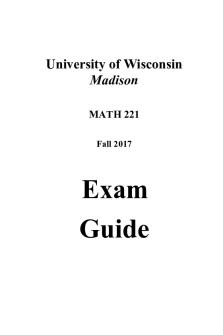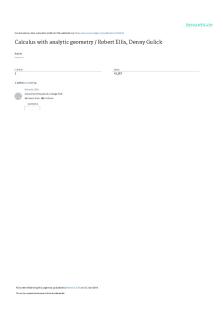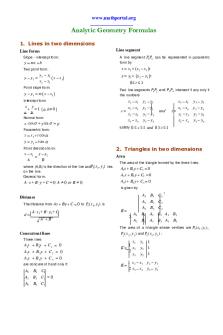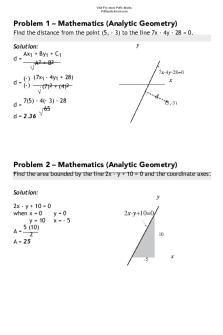Calculus And Analytic Geometry 1 - Final Exam Summary PDF

| Title | Calculus And Analytic Geometry 1 - Final Exam Summary |
|---|---|
| Author | Jase Lamardi |
| Course | Calculus And Analytic Geometry 1 |
| Institution | University of Wisconsin-Madison |
| Pages | 35 |
| File Size | 2.6 MB |
| File Type | |
| Total Downloads | 54 |
| Total Views | 148 |
Summary
Download Calculus And Analytic Geometry 1 - Final Exam Summary PDF
Description
University of Wisconsin Madison MATH 221 Fall 2017
Exam Guide
Review
Glimpses: ● For the general limit-finding problems: The very first thing you should do is to plug in the number. If you get the answer, then there is no need to apply any other techniques.
a If ou get a ue oe ∞, that gies ou . If ou get a ozeo ue oe , that gies ∞.
(c) If ou get ∞+∞ o a ue ties ∞, that is just ∞.
If afte pluggig i, ou get , ∞ , ∞ − ∞, the ou a eed to use soe tehiues below:
● Cancellation tricks: factoring, conjugate, etc The fist tik is ofte used he ou see . You at to ael soe tes so that ou a appl the liit. Here are some formulas to help with factoring: a2 −2 =a−a+ a3 − 3 = a − a2 + a + 2) a3 +3 =a+a2 −a+2).
● Dividing by power of x The second trick is often used when you see lim→∞, ad he the futio is a fatio. You ould at to diide the topueato ad otto deoiato the highest power of x. Two things to keep in mind:
1. You hae to diide the top ad otto eatl the sae thig. Fo eaple: dot divide the top by x, and the bottom by x2. 2. If there is square root, or square, you have to take them into consideration when finding the highest power. Fo eaple, if the futio is + / √ 2 + , the the highest poe is = , ad ou want to divide the top and bottom by x.
● Comparison/sandwich theorem The third trick is often used when you have something like sin, cos in your function, or something that can be bounded. Basically, you want to ”sandwich” your function between 2 things: · · · < f (x) < · · · and hopefully the two ends have same limit. Some useful bounds: . −≤si≤ . −≤os≤
● Continuity The condition for a function to be continuous at a point a is . li →a− eists . li →a+ eists 3. f(a) exists All the aoe ae the sae li →a− = li→a+ = fa.
● Asymptotes Keep i id the tpes of asptotes ee leaed 1. If limx→∞ f = L = ∞ eithe +∞ o −∞, the e sa that f has hoizotal asymptotes at y = L . If li→a f = ∞, e sa that f has etial asptotes at = a. . If li→∞ f / = L, e a do poloial diisio to fid the slat asptotes.
Derivative •
The derivative of any constant function is zero Let k(x)= c be a constant function. Then we have k′x = limh→0 kx+h − kx / h = limh→0 c−c / h = limh→0 0 = 0.
● The derivative of x n for n = 1,2,3,.... fa = li→a f−fa / -a = lim xn −an / -a Simplify the fraction (xn − an / − a. Fo = 2, we have x2 − a2 / -a = +a. Hence, d/ d n) = nxn-1.
●
The Differentiation Rules (source: Math Note Packet) We could go on and compute more derivatives from the definition. But each time, we would have to compute a new limit, and hope that there is some trick that allows us to find that limit. This is fortunately not necessary. It turns out that if we know a few basic deiaties suh as d/d = − the e a fid deiaties of aitail complicated functions by breaking them into smaller pieces. In this section we look at rules telling us how to differentiate any function written as either the sum, difference, product or quotient of two other functions.
•
Proof of Sum Rule Suppose that h = f + g fo all hee f ad g ae diffeetiale. The ha = lim x–> a h(x) - ha / -a = lim x–> a ( f + g - fa+ ga / -a = lim x–> a((f(x) - fa / -a + li x–> a ((g(x) - ga / x-a) = fa + ga
● Proof of produce rule Let h(x) = f(x)g(x). To nd the derivative we must express the change of h in terms of the changes of f and g: h − ha = fg − fafa = f g −f ga + f ga −f aga = f f − ga + f − ga a No diide − a ad let → a: li →a h − ha / - a = li →a fg − ga / - a + f − faga / - a = fag′a + f′aga
● Proof of Quotient rule We a eak the poof ito to pats. Fist e do the speial ase hee h = /g, and then we use the Product Rule to differentiate = f / g = f· /g . So let h = /g. We a epess the hage i h i terms of the change in g: h−ha = g−ga / gga Diidig − a, e get h − ha / -a = g − ga / g ga . - a) Using product rule and limits, limx–>a g(x) = g(a). limx–>a h−ha / - a = g′a / ga2 Theefoe = fg - fg / g2 .
● REMEMBER THESE: 2 sinx cosx = sin 2x Cos2 = os + / Sin2 x = (cos2x - /
● PROBLEM 1: Let f(x) = cos2x - cos x2 Fid : f ad {f} : f = - os si + si2 = - si + si2 {f} = - os + si2 + 2cosx2
● PROBLEM 2: Let f(x) = x5 Fid f (x) and f ‘(6)(x) : f = **** = f ‘(6) = =
From the above problem we can establish a general formula: Let f(x) = xn Then f ‘(n)(x) = n*(n-1)*(n-2).....2*1 And f ‘(n+1) (x) = 0
● PROBLEM 3: Let f(x) = x5 + + x3 - 2 Fid f ‘(5)(x) and f ‘(6)(x): f ‘(5)(x) = 5! F ‘(6) =
● PROBLEM 4: Fid (sin x) 7): = ((sin x) (*)) = si = cos x
•
Formulas: o f) = lim h––> f(x + h - f(x / h o f +- g = f +- g o fg = fg + fg o f/g = fg - fg / g2 o fg = fg * g o Cos2 x = (cos2x - / o Sin2 x = (cos2x - / o F[n] ‘(x) = n! o F[+] = o f +- g)(n) = f (n) +- g(n) (x)
● Dealing with equations of the form F1(x, y) = F2(x, y). If the ipliit defiitio of the futio is ot of the fo F , = ut athe of the fo F, = F, the ou oe all tes to the left had side, ad poeed to deal with a function y = f (x) that satisfies y2 + = =y2 + - xy = ad set F, = 2 + - xy.
● Derivatives of Inverse Trigonometric Functions. Recall that by definition the function y = arc sinx satisfies x = siny , and - π/ ≤ ≤ π/ . = d / d = d si / d = = os d/d = d/d = / os .
As we know, sin2+os 2y=1 =⇒ cosy=± sqrt(1−sin2=± st−2).
Hence, = d a si / d = / st-x2) Siilal, d a ta / d = / +2.
GOOD LUCK!
Functions and Derivatives Function 1. DERIVATIVE (Rate of change, slope, velocity) 2. INTEGRAL (length, Area, Volume) •
Derivation is approximation
Example: 32 = 9 But √ = .…(Approximate value)
Example: Use the tangent line of y=f(x) at x=x0
•
Key point: Find the slope of the line at x,y o Slope : y-y0 / x-x0 = f(x) -f(x0 ) / x-x0 o Definition : Slope of the tangent line of y=f(x) at x=x0 o lim f(x)-f(x0) / x-x0 = Δx= x-x0
● Average velocity: We all know what average velocity is. Instead of trying to find the velocity exactly at time t, we find a formula for the average velocity during some (short) tie iteal egiig at tie t. We’ll ite ∆t fo the legth of the tie interval. At time t we are s (t iles fo ou stat. A li le late, at tie t + ∆t e ae s (t + ∆t iles from our start. Theefoe, duig the tie iteal fo t to t + ∆t, e hae oed s (t + ∆t − st iles, Miles per hour: s (t+∆t −s t / ∆t and therefore our average velocity in that time interval was shorter we make the time iteal the salle e hoose ∆t the lose this ue should e to the instantaneous velocity at time t.
So we have the following formula (definition, really) for the velocity at time t v (t= li ∆t→ st+∆t−st / ∆t ● Acceleration as the rate at which velocity changes. As you are driving in your car your velocity may change over time. Suppose v (t) is your velocity at time t (measured in miles per hour). You could try to figure out how fast your velocity is changing by measuring it at one moment in time (you get v (t)), then measuring it a little later (you get v (t + ∆t {Aeleratio at tie t}=a= li∆t→ v (t+∆t − t / ∆t.
Limits ● Defiitio of liit st attept.
o If f is some function then li f = L →a is read “the limit of f(x) as x approaches a is L.” It means that if you choose values of x that are close but not equal to a, then f (x) will be close to the value L; moreover, f (x) gets closer and closer to L as x gets closer and closer to a. o The following alternative notation is sometimes used f(→L as →a; (Read “f (x) approaches L as x approaches a” or “f (x) goes to L as x goes to a”.) o Note that in the definition we require x to approach a without ever becoming equal to a. It’s important that x never actually equals a because our main motivation for looking at limits was the definition of the derivative. In Chapter II, equation (9) we defined the derivative of a function as a limit in which some ue ∆ goes to zeo: f′ = li f + ∆ − f. ∆→ ∆
o The quantity whose limit we want to take here is not even defied he ∆ = . Therefore any definition of limit we come up with had been not depend on what happes at ∆ = ; likeise, the liit li→a f should ot deped o hat f is.
● Basi properties of liits o
��� [ (�) + (�) ] = ��� (�) + ��� (�) : The limit of the sum of two functions is the sum of their limits.
o
��� [ (�) − (�) ] = ��� (�) − ��� (�) : The limit of the difference of two functions is the difference of their limits.
o ��� [ (� ) ∗ (�) ] = ��� (� ) ∗ ��� (�) : The limit of the product of two functions is the product of their limits. o ��� [ (� ) / (� ) ] = ��� (� ) / ��� (�) ; if li g is ot eual to zeo. The limit of the quotient of two functions is the quotient of their limits if the limit in the denominator is not equal to 0. o ��� ��ℎ ���� [ (� ) ] = ��ℎ ���� [ ��� (� ) ]. If n is even, lim f(x) has to be positive. The limit of the nth root of a function is the nth root of the limit of the function, if the nth root of the limit is a real number.
● The foral, authoritatie, defiitio of liit Our attempted definitions of the limit uses undefined and non-mathematical phrases like “closer and closer”. In the end we don’t really know what those statements really mean, although they are suggestive. Fortunately, there is a good definition, one that is unambiguous and can be used to settle any dispute about the question of whether lim � → � (�) equals some number L or not. Here is the definition.
● Defiitio of ���� → � �(�) = �. If f(x) is a function defined for all x in some interval which contains a, except possil at = a, the e sa that L is the liit of f as → a, if fo ee > , e a d a > depedig o suh that fo all x in the domain of f it is true that 0 < |� − � | < � ������� |(� ) − � | < � .
● Wh the asolute alues? The uatit|−| is the distance between the points x and y on the number lie, ad oe a easue ho lose is to alulatig |−|. The ieualit | − | < sas that the distae etee ad is less tha , o that ad ae lose tha .
What are ad ? The uatit is ho lose ou ould like f to e to its liit L; the uatit is ho lose ou hae to hoose to a to ahiee this. To poe that li→a f = L ou ust assue that soeoe has gie ou a uko > , ad the fid a positie fo hih { < | − a| < iplies |f(x − L| < . } holds. The ou fid ill deped o .
● Prole for pratie 1. ��� �– > ∞ �2 + 1/ 1010 � + 5 = ��� �– > ∞1 + 1/�2 / 1010 /� − 5/�2 = 1/0 = ∞
2. Show that ��� � → 5(2� + 1) = 11 . We have f(x) = 2x+1, a = 5 and L = 11, and the question we must answer is “how close should e to if at to e sue that f = + diffes less tha fo L = ? To figue this out e t to get a idea of ho ig |f − L| is: |(�) − �| = (2� + 1) − 11 = |2� − 10| = 2 · |� − 5| = 2 · |� − �|
So, if | − a| < the e hae |f − L| < , i.e. If |−a|< ½ then |f(x − L| e ae gie ou ill also e positie, ad if | − | < the e a guaatee | ( + − | < . at shos that li → + = .
Limits at infinity •
Instead of x approach some finite number, one can let x become “larger and larger” and ask what happens to f(x). If there is a number L such that f (x) gets arbitrarily close to L if one chooses x sufficiently large, then we write
��� � → ∞ (�) = �
(“The limit for x going to infinity is L.”) We have an analogous definition for what happens to f(x) as x becomes very large and negative: we write
��� � → −∞ (�) = �
(“The limit for x going to negative infinity is L.”)
Variatios i Liits •
Not all liits ae fo → a. Thee ae soe othe aiatios.
Left ad right liits •
When “x approach a” x is to be larger or smaller than a, as long as x “is close to a”. If we explicitly want to study the behavior of f (x) as x approaches a through values larger than a, then we write li ↘a f or li →a+ f or li →a+ f or li→a,>a f
•
All four notations are commonly used. Similarly, to designate the value which f(x) approaches as x approaches a through values below we write li↗a f or li→a− f or li→a− f or li→a, oe a fid a > such that a< < a+ = ⇒ |f − L| oe a fid a > such that � − < � < � =⇒ |�(�) − �| < Holds for all x in the domain of f. The following theorem tells you how to use one-sided limits to decide if a function f (x) has a limit at x = a.
Theore •
The two-sided limit limx–>a f(x) exists if and only if the two one-sided limits exist and have the same value. li ↘a f, ad li ↗a fX
Proles Questio: limx–>∞ (o.5 3 + / 5 - 5 +5) Ase: {Diide the ueato ad deoiato 5} = .5/ 5 + / 5 / - 5/4 + 5/ 5 = / =
Questio: limx–>∞ ( x/ + / / + ) Ase: {Diide the ueato ad deoiato /} = x -⅙ + / / + // {Pluggig i ifiit} = ∞/ =∞
Theorems {Sandwich & Substitution} ● The sadih theore Consider that f ≤ g ≤ h
For all the value of x and both the limits
lim x–>a f ad li x–>a h
Exist and are equal to the same value L. Then
lim x–>a g(x)
also exists and is equal to L.
o The theorem is useful when we want to know the limit of g, and when we can sadih it between two functions f and h whose limits are easier to compute. The Sandwich theorem looks like the first theorem of this section, but there is an important difference: in the Sandwich theorem we don’t have to assume that the limit of g exists. The ieualities f ≤ g ≤ h oied ith the iustae that f and h have the same limit are enough to guarantee that the limit of g exists.
● Sustitutio of liits Given two functions f and g, we can consider their composition h(x) = f (g(x)). To compute the limit Li →a f g
We let u = g(x), so that we want to know
Li →a f u hee u = g.
If we can find the limits
L=li →a g ad li u→L f(u)=M
Then it seems reasonable that as x approaches a, u = g(x) will approach L, and f (g(x)) approaches M. This is in fact a theorem:
Theore: If li→a g = L, ad if the futio f is otiuous at u = L, the
li→a f g = li u→L fu = fL
Another way to write this is
li→a fg = f li→a g .
What this statement means is that we can freely move continuous functions outside of limits.
● Proles Questios: limx–>5 st - - / -5
Ase: = limx–> (sqrt(x - 1) - 2) / (x-5) = {Multipl Cojugate} = (x-5) / ((x-5) * sqrt(x-1) + 2) = / {pluggig i }
Questio: Poe that li u–>∞ si u/ u = sustitutio/sadih theoe.
Ase: = - ≤ si u ≤ = - |si u /u | ≤ si u/u ≤ |si u| =0 Questio: lim x–> ∞ (x1/2 - (x2 + x)1/2) / 1 Ase: = ojugate ad sole pluggig
Questio: limx–>∞ (x - (x2+ x)1/2)
Ase: = Multipl Cojugate = Divide the numerator and denominator by x = -1/1+1 = -½
Proof and Problems ( lim x––> 0 (Sin x / x = 1)) ● PROOF OF lix–> si / o To compute specific formulas for the derivatives of sin x and cos x, we need to udestad the ehaio of si / ea = . The defiitio of si θ as the coordinate of a point on the unit circle to poe that liθ→ siθ / θ = . The aiale e’e iteested i is a agle, ot a hoizotal positio, so e ill disuss si θ / θ athe tha si / .
o Coside the adius of the ile , θ is the legth of the highlighted a. This is tue he the agle θ is desied i adias. Also, sie the adius of the ile is , si θ = |opposite| euals the |hpoteuse| legth of the edge idiated (the hypoteuse has legth . I othe ods, si θ/θ is the atio of edge legth to a legth. Whe θ = π/ ad, si θ = ad si θ / θ = /π ∼= 2/3. When θ = π/ ad, si θ) = √2/2 and sin (θ) / θ = 2 = 9/10. What will happen to the value √2/π ∼ of sin (θ) / θ as the value of θ gets closer and closer to 0 adias? It ill shik as θ shiks, the legth si θ of the seget gets lose ad lose to the legth θ of the ued a. We olude that as θ → ,
si θ / θ ––> In other words limx––> sin x / x = 1.
● Proles Questio: lim x––> x / tan x
Ase: = x / (sin x /cos x) = (x / sinx) * cos x = cos x = 1 (cos 0 = 1)
Questio: lim x––> sin 5x / x
Ase: = (sin 5x / 5x) / (x / 5x) = 5 x / x =5
Some basic Trigonometric Formulas to solve with ● ● ● ● ●
Sin2 ϴ + cos 2 ϴ = 1 tan2 ϴ + 1 = sec 2 ϴ 1 + cot2 ϴ = cosec 2 ϴ sin (2ϴ) = 2 sinϴ cosϴ Cos (2ϴ) = 1 − 2 sin2 ϴ
. Li x––> (Si / Si 4x = si / {diidig the ueato ad deoiato } = / {diidig ueato ad deoiato } =¾
. Li x––> (-os / 2 = 1-cos2x / x2(1+cos x) =Sin2x / x2(1+cos x) = 1/ 1+ cos x = 1/ (1 + 1) =1/2
Introduction to Continuity ● Defiitio of Cotiuit A function g is continuous at a if lim x → a g(x) = g(a) A function is continuous if it is continuous at every a in its domain. Note that when we say that “a function is continuous on some interval” it has to be defined on that interval. For example, the function f(x) = 1/x2 is continuous on the iteal < < ut is ot otiuous o the iteal − < < 1 because it isn’t defined at x = 0. Continuous functions are “nice”, and most functions we will want to talk about will be continuous. For example, all polynomials are continuous functions. The ideas in the proof are the same as in the following example.
Eaple A polynomial that is continuous. Let us show that P(x) = x2 + 3x is continuous at x = 2. To sho that e hae to poe that li →2 P(x) = P (2) Solutio We can do this two ways: using the defiitio ith ad the had a. It is uh easier to the limit properties (P1)...(P6) from §6: for example, li → 2 + = li → 2 + li → = li → ) · (li → ) + (li → ) · (li → =2·2+3·2 And this is what we wanted.
Asymptotes •
Asymptotes can be vaguely defined by saying that a line is an asymptote of the graph of a function y = f(x) if the graph “approaches the line as x approaches infinity.” For a more precise definition we distinguish between three cases, depending on the line.
•
Vertial Asptotes If y = f (x) is a function for which either li↘a f=∞, ...
Similar Free PDFs

Trigo-and-geometry-exam
- 5 Pages

CALCULUS-BASED PHYSICS 1 Final Exam
- 31 Pages
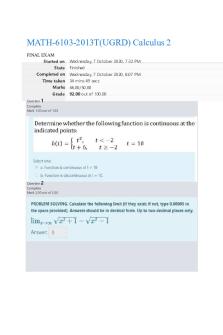
Calculus 2 Final EXAM - das
- 46 Pages

Calculus 1 Final
- 21 Pages

Calculus 1 Midterm Exam
- 6 Pages
Popular Institutions
- Tinajero National High School - Annex
- Politeknik Caltex Riau
- Yokohama City University
- SGT University
- University of Al-Qadisiyah
- Divine Word College of Vigan
- Techniek College Rotterdam
- Universidade de Santiago
- Universiti Teknologi MARA Cawangan Johor Kampus Pasir Gudang
- Poltekkes Kemenkes Yogyakarta
- Baguio City National High School
- Colegio san marcos
- preparatoria uno
- Centro de Bachillerato Tecnológico Industrial y de Servicios No. 107
- Dalian Maritime University
- Quang Trung Secondary School
- Colegio Tecnológico en Informática
- Corporación Regional de Educación Superior
- Grupo CEDVA
- Dar Al Uloom University
- Centro de Estudios Preuniversitarios de la Universidad Nacional de Ingeniería
- 上智大学
- Aakash International School, Nuna Majara
- San Felipe Neri Catholic School
- Kang Chiao International School - New Taipei City
- Misamis Occidental National High School
- Institución Educativa Escuela Normal Juan Ladrilleros
- Kolehiyo ng Pantukan
- Batanes State College
- Instituto Continental
- Sekolah Menengah Kejuruan Kesehatan Kaltara (Tarakan)
- Colegio de La Inmaculada Concepcion - Cebu
